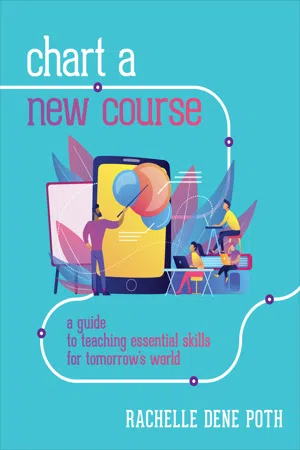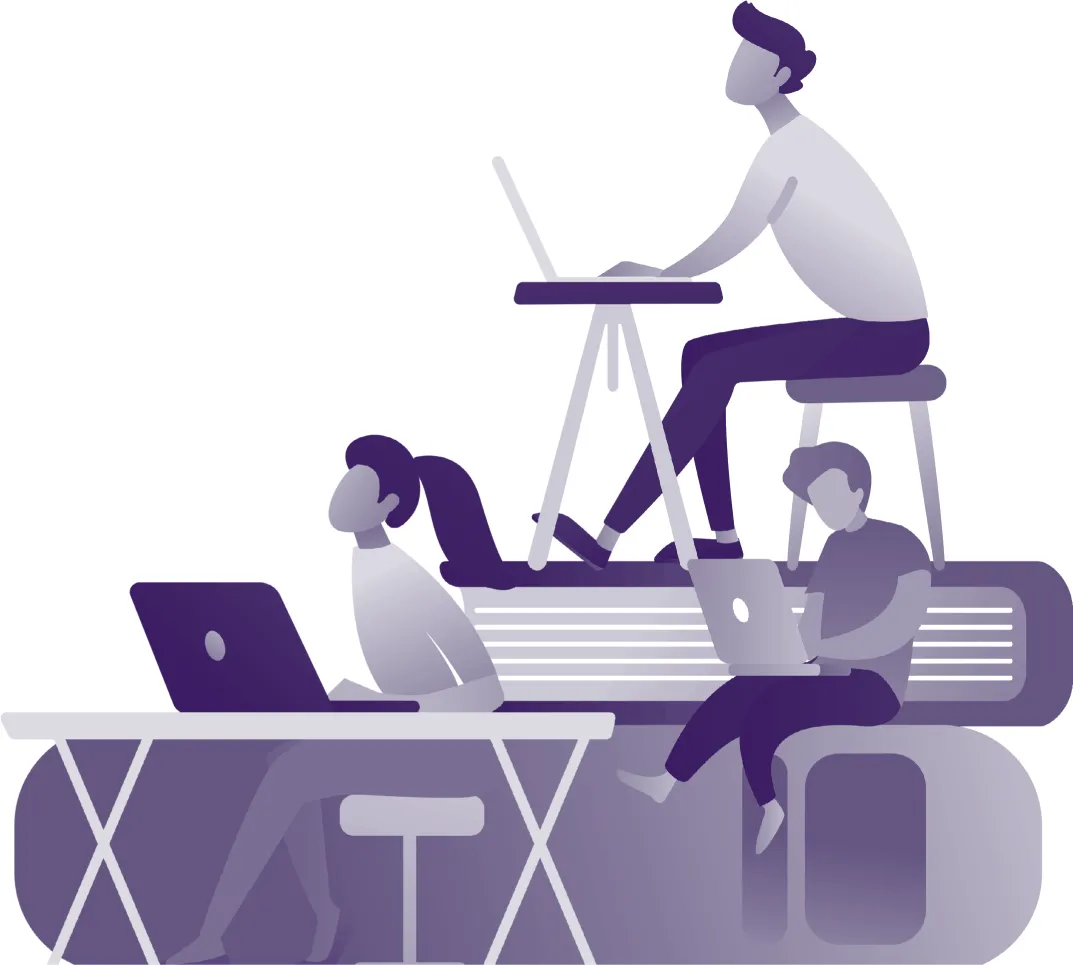CHAPTER 1
CONNECTIONS & PRESENCE
Navigating the Digital World
As educators in the digital age, we must continually explore possibilities for amplifying learning in our classrooms. One such possibility is to embrace the use of technology to enable students to create an online presence. This chapter addresses the importance of establishing an online presence and explores the ins and outs of interacting in the virtual space. Finally, it discusses how you can apply your new knowledge to a real classroom setting to support your students. In this chapter, you will learn:
• Ways to develop social presence in physical and digital spaces
• How to help students navigate in a digital world
• How to help students learn to share their ideas online responsibly
• How to build foundational skills for using technology
• Ideas for students to develop their interpersonal communication skills in all learning spaces—in and out of the classroom
• How to cultivate innovative forms of creativity
Establishing a Connection
As educators, we serve in many different roles with many responsibilities. However, we must stay focused on our most important goals: to prepare students for whatever the future may bring and to create opportunities to empower our students to drive their own learning. As Nelson Mandela stated in his 1990 speech to Madison Park High School, “Education is the most powerful weapon which you can use to change the world” (WGBH News, 2013). We must be intentional in exploring new and innovative ways to meet the changing needs of our students and the changing world we live in. To provide the best opportunities for our students, we must start by creating a supportive learning environment and helping them develop critical skills that will benefit them regardless of what they choose to pursue after high school, whether they’re entering the workforce or continuing their education.
It’s important to find ways to motivate students, increase student engagement, and spark curiosity for learning. Designing instruction to involve students in more authentic and meaningful tasks will lead to an increase in students’ sense of engagement and as a result, improve their motivation to learn. When teachers design an environment that provides both structure and student autonomy, engagement will increase for students (Ryan & Deci, 2000, p. 70–71). Motivated, engaged students retain more of the content and also develop the vital skills of collaboration, communication, and creativity—skills needed for their future.
By setting a personal example with your own behavior, providing a relaxed and supportive environment where learning can flourish, and developing good relationships with students, you can establish a solid foundation from which they can grow. The most important first step is to develop positive, mutually respectful, and collaborative student-teacher and student-student relationships. I make this a priority in my classroom, and I believe that in addition to the traditional methods we rely on for connecting with our students, technology offers many possibilities to facilitate these connections in a safe virtual space and when timing is critical. Being able to provide the access to resources that students and families need is important. Although the goal is to create a space to facilitate communication between educators and students, we want to make sure we use the right digital tools that guarantee student safety and privacy.
The activities and structure of classrooms can be made more interesting and engaging today by leveraging the technology available, whether using specific devices or finding apps for students to use in ways that are beneficial, promote more student autonomy, and give students the power of choice. Some possibilities could include sharing content in a blog, interacting in a Twitter chat, using a school-approved messaging app, or exchanging ideas and class resources via a class website. In Chapter 5, you’ll learn about more activities for building digital citizenship skills and interpersonal skills by setting up a Skype call with another classroom from around the world and sharing ideas through digital spaces such as Edmodo (new.edmodo.com) and Flipgrid (info.flipgrid.com). We can leverage technology to help students build their interpersonal skills and become responsible digital citizens.
An important lesson for students is to develop their social presence in the physical and digital space. In addition to supporting students in learning course-specific material, we teachers have a second, equally important role: helping students develop a presence in the classroom (Baker, 2010). Whether the learning takes place in a face-to-face environment or online setting, interaction is “at the heart of the learning experience” and has been cited as a defining characteristic of successful learning in each of these settings (Baker, 2010). Our students need our help in learning to interact in all settings. With the increase in the use of technology in the classroom and in the world, we must actively engage our students in responsible exploration of the digital world and social interactions.
Online learning is convenient and allows for more flexibility for learning. Convenience, however, does not mean it should be used simply as a shortcut for traditional activities. We must ensure we create a learning environment, or a virtual space, where we provide the right components to promote social learning and a feeling of connectedness with the content and students’ peers. Because we interact in so many ways today, we must be intentional about helping students to develop the right skills for these interactions.
Through social presence, we portray our personality, character, and style—in both a traditional and an online learning environment. In the traditional classroom space, we work to establish our teaching presence so we can create authentic relationships with our students, establish supportive connections, and develop the relationships that are essential to student learning. Through our “presence,” we communicate to others who we are, share our beliefs about teaching and passion for learning, show our dedication to our students, and demonstrate our commitment to their success. By developing your own presence in person and online, you can model and promote social interactions and engage students in meaningful ways.
Now more than ever, we have to focus on social interactions, help students develop their identities, and build skills of collaboration and communication that will benefit them in the future. Online we can find many tools that help foster the development of presence and enhance the collaboration between teachers and learners in the classroom or learning space. It’s important for classrooms to support students in developing their own social presence as well as to allow students to have input regarding their learning environment and make some of the decisions that affect them. Social presence connects all aspects of the learning environment, and that includes how teachers and students share and express their respective background knowledge and experiences (Whiteside, 2015).
Traditional Skills in the Digital Age
Because many of today’s students have grown up relying on technology to find information, to communicate, and to collaborate, they began creating their digital footprint and presence much earlier than most of us did. Researching topics, completing calculations, and even watching TV require only a tap of a smartphone, tablet, or keyboard. The struggle of juggling multiple devices or relying on the Dewey Decimal System and physically searching through books are vanishing skills, but they should not be. Regardless of the ease provided with digital tools, the essential skills for completing research remain the same.
Students need to be able to locate, analyze, and create a representation of their learning, and they need to know how to cite it properly. They need to understand traditional research methods and tools in preparation for future technology changes or lack of technology. Who knows what glitches, technology issues, or circumstances the future will hold? Helping students understand that we can all survive without being dependent on the technology is important—and it’s important that we model this too. We need to show them how to employ the traditional methods of research and information seeking that will be required in their future, regardless of what technology is available. But how?
Making a Connection While Teaching Skills
In my classroom, I try to make connections with my students as often as possible. Sharing my own experiences with learning, the changes I have seen in education, and comparing my experiences with my students’ adds to our classroom culture. It definitely offers a more authentic way to learn—even about research skills. Try making time to talk about these changes, then brainstorm ideas and solutions to extend the discussion. For example, you and your class could explore, role-play, and gather ideas about how people were able to find information without computers, web searches, or virtual assistants. Ask for your students’ ideas with such questions as:
• How did students gather information for their reports?
• Where did they go to learn more about a certain topic?
• How did they communicate with other people beyond the school day?
• What did they do when their questions had to wait until the next school day?
• What happened if students could not find enough resources?
It is important to have these conversations, because as good as technology can be, students still need the skills to do the work or complete the tasks, without the benefit of tech. In learning, students need to experience productive struggle. There are no guarantees of the types of tools they will need in the future, so to prepare them for the unknown, we must prepare them with everything that we do know.
A key goal should be to help students understand that as technology evolves, people will become even more reliant on it for multiple reasons: perhaps to save time, because it’s a better way to connect or find information faster, or maybe even to experience something that otherwise is not possible in the traditional classroom based on time or location.
Consider a little search engine experiment I like to involve students in at the start of each year. I use Google to conduct a simple search for a few education and technology terms:
• ’80s technology: 58,800,000 results in 0.71 seconds
• Artificial intelligence: 604,000,000 results in 0.70 seconds
• Education: 6,040,000,000 results in 0.74 seconds
• School: 11,270,000,000 results in 0.75 seconds
• Dewey Decimal System: 1,800,000 results in 0.83 seconds
The number of results available between these five terms was interesting. The terms chosen were based on our beginning of the year discussions in my STEAM course as we explored technology and its changes since I was the same age as my students. They were amazed at the number of results returned in less than one second and that “Dewey Decimal” returned such a low number. They were also amazed at the ...


